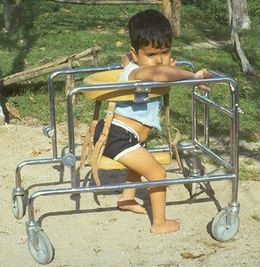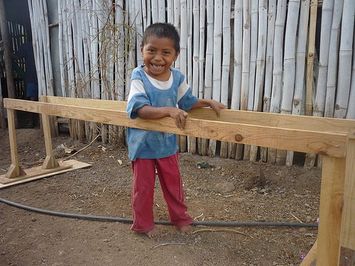Hesperian Health Guides
Prevention and Correction of Contractures
HealthWiki > Disabled Village Children > Chapter 22: Spina Bifida > Prevention and Correction of Contractures
|
CAUTION! Do stretching exercises only where there is stiffness or limited range of motion. When joints are floppy, do not stretch them more where they already bend too much.
For example: | |||
| If the foot is stiff in this position, | do exercises to gradually bring the foot up. |
YES
| |
| But if the foot is floppy or already bends up more than is typical, |  |
avoid exercises that would stretch it even more. |
NO
|
Because children with spina bifida have stronger muscles for bending than for straightening the hips, they tend to develop hip contractures, like this child. Stretching exercises and lying on the belly may help.
 angle of contracture.
Tight tendons keep hip from straightening. |
Also, make sure walking aids help correct rather than increase the contractures.
 |
 |
| This expensive metal "walker" lets this child with spina bifida walk with hips bent. It can cause hip contractures and make walking without aids less possible. | When the child is changed to parallel bars adjusted to the right height, he walks more upright. This helps prevent contractures and increases the possibility of walking without aids. |
| Sometimes a child stands with hips and knees bent, partly because his feet bend up too much. This can lead to hip and knee contractures. |
 |
 |
| Lightweight below-knee braces that hold the feet in a more firm position may be all the child needs to stand straighter, walk better—and prevent contractures. |
This page was updated:22 May 2025




